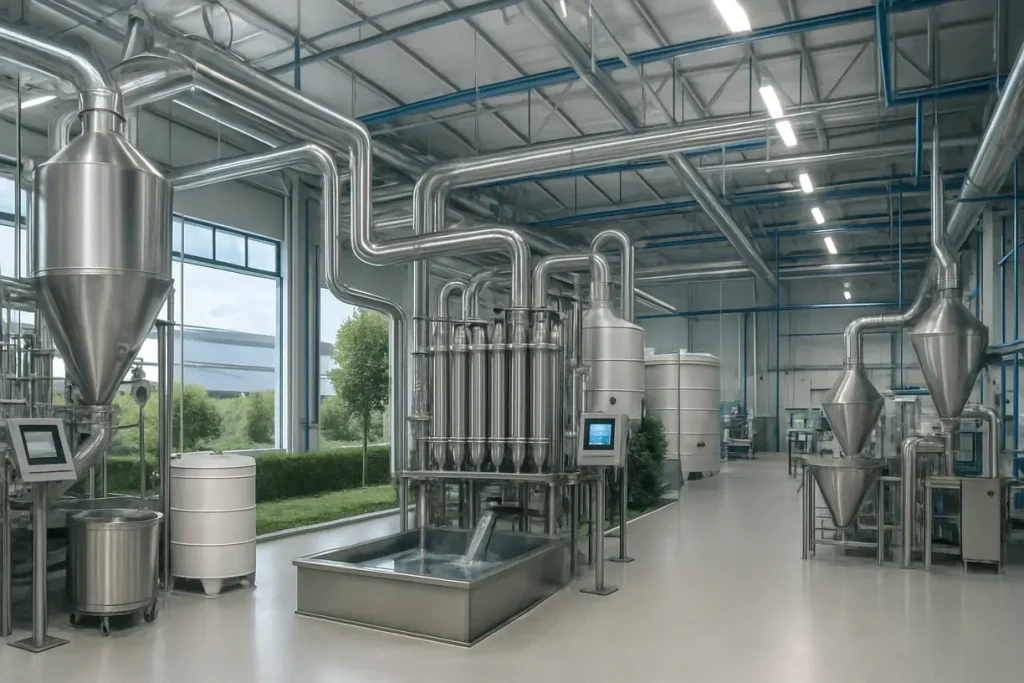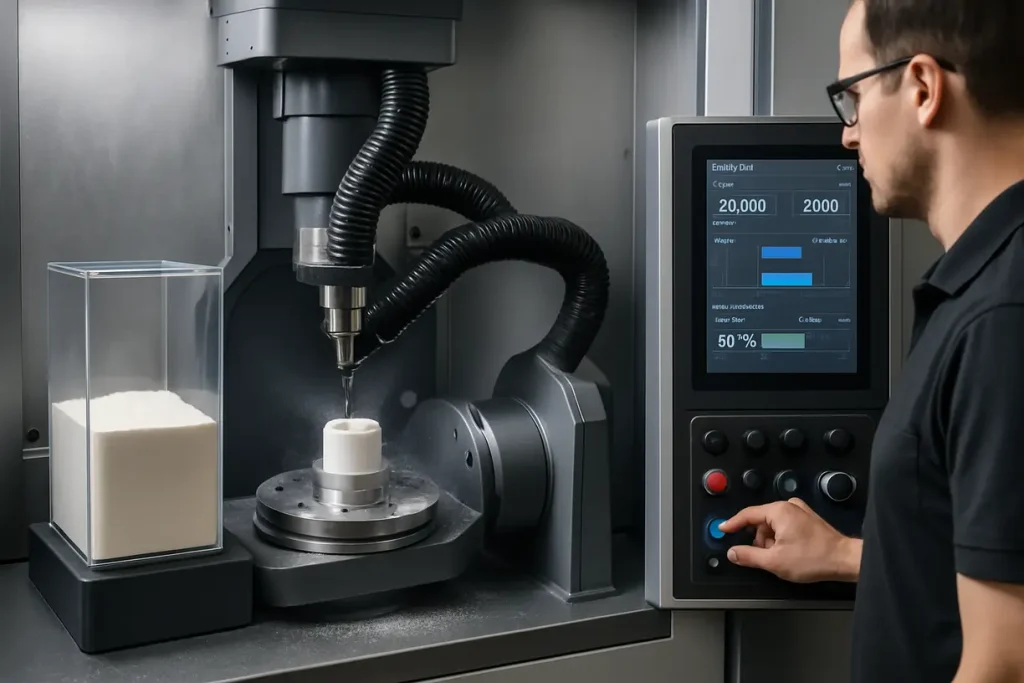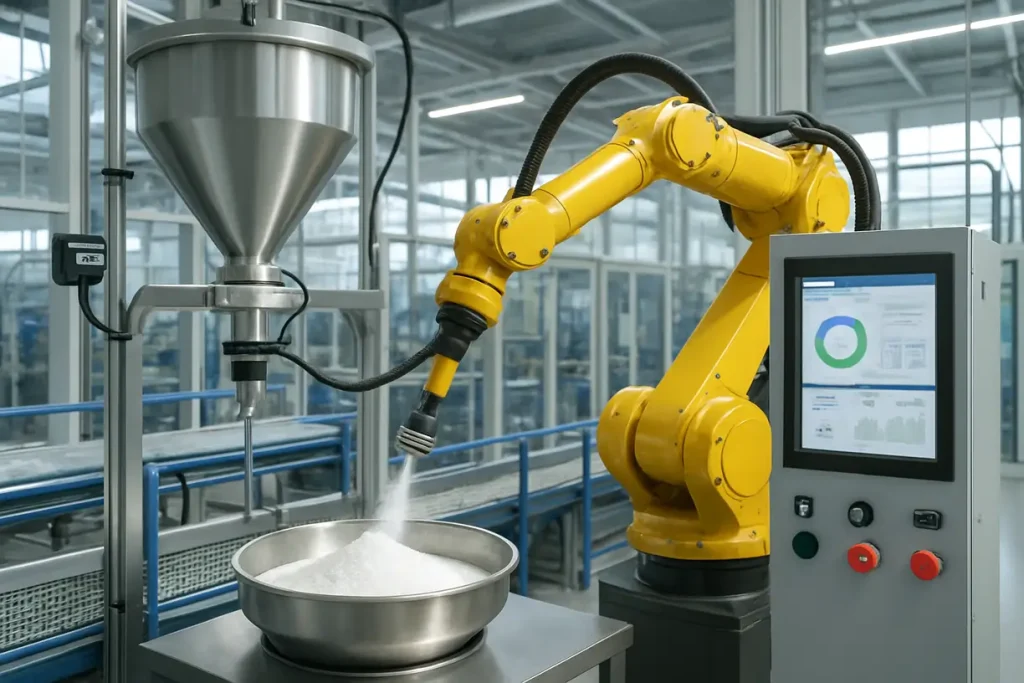The emergence of sustainable processing methods for zirconia powder production is becoming increasingly vital in today’s manufacturing landscape. As industries face pressure to reduce their environmental impact, purchasing managers and decision-makers seek solutions that address sustainability without compromising quality. This article serves as a comprehensive guide, identifying key sustainable practices and technologies that enhance zirconia production. By presenting actionable insights, manufacturers can better align their operations with sustainability goals, leading to reduced costs and improved reputation.

The image depicts a modern, sustainable zirconia powder production setup highlighting eco-friendly processing techniques.
What Are the Current Trends in Zirconia Powder Production?
Zirconia powder is essential in various applications, including ceramics, abrasives, and dental materials. Its unique properties, like strength and thermal stability, make it a preferred choice among manufacturers. Recently, the industry has witnessed several trends focusing on sustainability, driven by both regulatory pressures and consumer demand. Many manufacturers are now prioritizing greener methods to produce zirconia powder, recognizing the importance of reducing environmental footprints.
One significant trend is the shift towards low-energy processes. These techniques reduce energy consumption during production, making it easier for companies to operate sustainably. For instance, processes now utilize advanced kilns and more efficient heating methods that minimize energy use, leading to a substantial decrease in operational costs.
In addition, there is a growing emphasis on waste minimization. Manufacturers are not just looking at emissions but also how to repurpose or recycle materials used in production. Initiatives such as closed-loop recycling help companies reclaim materials, thus reducing the overall waste generated and promoting a circular economy.
Furthermore, the integration of closed-loop systems for recovering materials is gaining traction. This approach not only enhances the sustainability of operations but also improves overall efficiency. Companies are increasingly employing technologies that allow for the capture and reuse of byproducts, which can be incorporated back into the production cycle.
Key Trends in Zirconia Powder Production:
- Adoption of Low-Energy Processes: Utilizing advanced kilns and innovative equipment to conserve energy.
- Recycling and Waste Minimization: Implementing closed-loop systems to reclaim and reuse materials.
- Renewable Energy Integration: Incorporating solar or wind energy into production to reduce reliance on fossil fuels.
For instance, some organizations have started implementing new methods that incorporate renewable energy sources, making their operations cleaner and more sustainable. This transition not only benefits the environment but also positions companies favorably in the eyes of consumers and regulators. By adopting these trends, manufacturers can reduce operational costs and contribute positively to their corporate social responsibility agendas.
In summary, the current trends in zirconia powder production reveal a clear movement towards sustainability, characterized by energy efficiency, waste reduction, and the adoption of innovative technologies. These trends not only align with environmental goals but also drive operational benefits, making them essential for future competitiveness.
Why Is Sustainability Important for Zirconia Production?
Sustainability is crucial for zirconia production for several reasons. First and foremost, it addresses environmental concerns. Traditional zirconia production methods often result in high energy consumption and significant carbon emissions. In a world increasingly focused on climate change, moving towards sustainable practices is no longer optional; it’s essential for the survival of many companies.
Moreover, adopting sustainable methods can yield economic benefits. For example, companies that invest in energy-efficient technologies often see lower operational costs in the long run. This can be particularly appealing for purchasing managers who are constantly looking for ways to improve their company’s bottom line.
Key Benefits of Sustainability in Zirconia Production:
- Cost Savings: Investments in sustainable technologies often lead to lower utility bills and reduced waste disposal costs.
- Regulatory Compliance: Companies prioritizing sustainability are better positioned to meet evolving environmental regulations, minimizing legal risks.
- Enhanced Brand Image: A commitment to sustainability builds consumer trust and loyalty, particularly among environmentally conscious customers.
- Resource Conservation: Sustainable practices often involve the efficient use of raw materials, reducing the overall demand for resources.
Sustainability also fosters compliance with regulations. Governments worldwide are implementing stricter environmental standards. Companies prioritizing sustainability are better positioned to meet these requirements, avoiding potential fines or production halts.
Lastly, consumers are becoming more ecologically conscious. They prefer brands that demonstrate a commitment to sustainability. A company’s reputation can significantly benefit from sustainable practices, establishing trust and loyalty with customers.
In summary, the importance of sustainability in zirconia production encompasses environmental protection, economic gain, regulatory compliance, and enhanced brand image. By committing to sustainable practices, companies can secure a competitive edge while positively impacting the planet.
What Innovative Techniques Are Emerging?
The push for sustainability has led to several innovative techniques in zirconia powder production. These advancements focus on improving efficiency while reducing environmental impacts.
One notable technique is solvent-free processing. This method eliminates the use of harmful solvents, which not only improves safety but also reduces waste. Companies utilizing this technique often report better overall material yields and lower production costs.
Another innovation is bio-derived additives. Manufacturers are exploring natural alternatives to traditional synthetic additives used in zirconia production. These bio-derived materials can enhance properties without introducing harmful substances, aligning with green chemistry principles.
Moreover, advancements in 3D printing technology are revolutionizing zirconia applications. This technique allows for more precise usage of materials, reducing waste and energy usage. For instance, dental labs are increasingly using 3D printing with zirconia to create customized dental fixtures, minimizing excess material.
To highlight the impact of these techniques, some organizations report significant reductions in energy consumption and waste generation. As more companies adopt such innovations, the overall sustainability of zirconia powder production is likely to improve.
| Innovative Technique | Description | Benefits |
|---|---|---|
| Solvent-free processing | Eliminates harmful solvents; reduces waste | Improved safety, lower costs |
| Bio-derived additives | Uses natural alternatives to enhance materials | Eco-friendly, less harmful |
| 3D printing | Allows for precise material use in applications | Reduces waste, energy usage |

The image illustrates innovative zirconia processing techniques, showcasing eco-friendly methods and advanced technology in action.
How Do Alternative Raw Materials Benefit Production?
Using alternative raw materials in zirconia powder production offers numerous benefits that can enhance both sustainability and efficiency. First, these materials can reduce reliance on conventional sources, making the supply chain more resilient. This adaptability is crucial in a world facing resource shortages, where supply disruption can significantly impact production.
For instance, recycled zirconia can often be reprocessed and used in new products, which lowers costs and reduces waste. Companies can take existing zirconia waste materials and refine them for new applications, promoting a circular economy. This not only conserves resources but also aligns with sustainability goals.
Additionally, incorporating bio-based materials can enhance the ecological footprint of production. These materials, derived from renewable sources, can reduce overall emissions tied to production processes. For example, using bio-based binders in ceramic production can lower the environmental impact compared to traditional petrochemical-derived binders.
However, transitioning to alternative materials requires careful consideration of their properties. If not correctly evaluated, this change can lead to product inconsistencies. Thus, thorough testing and validation are essential to ensure that quality is maintained throughout the production process.
Benefits of Alternative Raw Materials:
- Resource Conservation: Reduces dependency on finite natural resources.
- Waste Reduction: Encourages recycling and repurposing of materials, lowering overall waste.
- Lower Emissions: Bio-based options can reduce greenhouse gas emissions during production.
- Cost Efficiency: Using recycled materials can lead to significant cost savings over time.
- Improved Corporate Image: Adopting sustainable practices enhances brand reputation among environmentally-conscious consumers.
| Alternative Material | Benefits | Considerations |
|---|---|---|
| Recycled zirconia | Reduces waste, lowers costs | Quality assurance needed |
| Bio-based materials | Decreases emissions, supports renewable sourcing | Needs performance testing |
In summary, the incorporation of alternative raw materials can significantly benefit zirconia powder production by enhancing sustainability, reducing costs, and lessening environmental impact. As manufacturers increasingly embrace these practices, they contribute to a more sustainable and efficient production landscape.
What Role Does Technology Play in Sustainable Processes?
Technology is a driving force in the evolution of sustainable zirconia powder production. Modern manufacturing technologies help companies optimize operations and significantly reduce their environmental impacts.
For example, advanced data analytics allow companies to monitor energy consumption and emissions in real-time. This capability enables businesses to identify inefficiencies and implement corrective measures swiftly. As a result, they can lower operational costs and lessen their carbon footprint.
Automation also plays a crucial role. Implementing automated systems can enhance production efficiency, allowing for precise control over various stages of the manufacturing process. This not only reduces human error but also minimizes material waste, which is vital in sustainable manufacturing.
Moreover, the adoption of Internet of Things (IoT) solutions facilitates smarter manufacturing. Sensors in production lines can provide feedback on equipment performance, predicting maintenance needs before failures occur. This ensures that operations run smoothly and efficiently.
As companies continue to explore these technologies, the potential for achieving sustainability goals will increase. Undoubtedly, those investing in technology today will be better positioned for success in the future.
| Technology | Role in Sustainability | Benefits |
|---|---|---|
| Data analytics | Monitors and optimizes energy use | Cuts costs, reduces waste |
| Automation | Enhances production efficiency | Minimizes human error |
| IoT solutions | Enables smart manufacturing | Improves system reliability |

The image shows advanced sustainable manufacturing technology, showcasing IoT and automation applications in zirconia powder production.
How Can Companies Optimize Their Supply Chain?
Optimizing the supply chain is essential for achieving sustainability in zirconia production. Companies can adopt several strategies to improve their sourcing and logistics practices.
First, prioritizing local sourcing of materials can significantly reduce transportation emissions. When companies purchase materials closer to their production facilities, they reduce fuel consumption. This not only aids sustainability efforts but can also lower costs associated with logistics.
Additionally, establishing strong relationships with suppliers who are committed to sustainability can enhance supply chain performance. Companies should seek partners that share their environmental values. This kind of collaboration can lead to innovations in sustainable practices across the supply chain.
Moreover, leveraging technology for supply chain management is vital. Using software tools for inventory and logistics management can improve efficiency. This ensures that the right materials are available when needed, reducing excess inventory and minimizing waste.
Lastly, implementing sustainable logistics practices can further enhance efficiency. This includes strategies such as optimizing transportation routes and using eco-friendly vehicles for delivery.
| Supply Chain Strategy | Benefits | Implementation Tips |
|---|---|---|
| Local sourcing | Lowers transportation costs and emissions | Identify nearby suppliers |
| Supplier partnerships | Encourages shared sustainability goals | Evaluate supplier practices |
| Technology in logistics | Enhances inventory management and reduces waste | Invest in supply chain software |
What Are the Economic Impacts of Sustainable Methods?
The economic impacts of adopting sustainable methods in zirconia production are multifaceted. By focusing on sustainability, companies can realize significant cost savings and improved financial performance.
For one, energy-efficient practices lead to reduced utility bills. Manufacturers often find that investing in energy-efficient equipment pays off quickly through savings over time. This is important for purchasing managers looking to balance budget constraints with innovation.
Furthermore, sustainable practices can enhance profitability by attracting more customers. As consumers increasingly demand eco-friendly products, businesses that position themselves as sustainable can gain a competitive advantage. This can either lead to increased sales or allow companies to charge premium prices for their products.
Additionally, engaging in sustainable practices can lead to lower risks associated with regulatory compliance. Companies that proactively implement environmentally friendly processes often face fewer fines and legal fees related to environmental violations.
To summarize, the economic benefits of sustainability in zirconia production can be profound, impacting both the bottom line and brand reputation.
| Economic Impact | Description | Long-Term Benefits |
|---|---|---|
| Lower operational costs | Energy efficiency reduces bills | Improved profit margins |
| Increased customer base | Eco-friendly appeal attracts consumers | Potential for higher pricing |
| Reduced regulatory risks | Proactive sustainability compliance decreases liabilities | Less financial risk |
What Regulations Influence Sustainable Zirconia Production?
Manufacturers in the zirconia industry must navigate various regulations that impact their sustainability efforts. Understanding these regulations is crucial for ensuring compliance and fostering environmentally responsible practices.
Government bodies at international, national, and local levels are increasingly enacting environmental regulations. These often cover emissions, waste management, and resource usage. Companies must stay informed about these regulations to avoid potential fines and maintain their operational licenses.
One prominent example is the European Union’s RoHS Directive, which limits the use of hazardous substances in manufacturing. Compliance with such regulations not only minimizes environmental harm but also positions companies favorably in the marketplace.
In addition to adhering to strict regulations, companies can also look to ISO standards. The ISO 14001 standard, for instance, provides a framework for effective environmental management systems. Achieving certification can enhance a company’s reputation and demonstrate its commitment to sustainability.
In essence, being aware of and compliant with regulations can provide manufacturers with a competitive edge, ultimately fostering long-term success.
| Regulation | Focus Area | Compliance Benefits |
|---|---|---|
| EU RoHS Directive | Limits hazardous substances in manufacturing | Reduces environmental impact |
| ISO 14001 | Framework for environmental management | Enhances reputation |
How Can Companies Measure Sustainability Success?
Measuring sustainability success is critical for companies in the zirconia powder production sector. Organizations can use various key performance indicators (KPIs) to evaluate their progress toward sustainability goals.
One primary KPI is the carbon footprint, which quantifies greenhouse gas emissions from production processes. Regularly assessing the carbon footprint enables companies to identify areas for improvement, set targets, and track progress over time.
Another important metric is waste reduction. By measuring waste generated in relation to output, companies can refine their processes, ultimately reducing waste and minimizing costs. This is essential for maintaining an efficient production system.
Additionally, water usage is a significant sustainability metric. By tracking water consumption, firms can adopt practices that minimize water usage, further contributing to sustainable operations.
Moreover, customer feedback can act as a KPI. Understanding consumer perceptions of a company’s sustainability efforts can inform further improvements and help businesses align better with market expectations.
| Sustainability Metric | Importance | Measurement Techniques |
|---|---|---|
| Carbon footprint | Indicates total emissions | Regular audits and assessments |
| Waste generation | Reflects efficiency and resource management | Track waste per production unit |
| Water usage | Measures efficiency and conservation | Monitor consumption rates |
What Challenges Do Companies Face in Adoption?
Despite the clear benefits of sustainable zirconia powder production, companies often encounter several challenges when implementing these practices. Identifying these obstacles is the first step towards overcoming them.
One significant challenge is the initial cost of upgrading equipment. While sustainable technologies can lead to long-term savings, the upfront investment can be daunting for some organizations. Thus, businesses must balance long-term benefits with short-term budgets.
Another challenge is the lack of awareness or understanding of sustainable practices among staff. Training employees on new technologies and processes is vital for successful implementation. Without proper education, businesses may struggle to reach their sustainability goals.
Furthermore, transitioning to sustainable sourcing practices can be complex. Ensuring that suppliers share sustainability values might require extensive research and collaboration, increasing the complexity of supply chain management.
Finally, navigating evolving regulations can pose a challenge. Companies need to stay updated on new legislation and adjust practices accordingly, which can be time-consuming.
By addressing these challenges, companies can successfully integrate sustainability into their operations, leading to improved outcomes.
| Challenge | Description | Potential Solutions |
|---|---|---|
| Initial cost of equipment | High upfront costs for sustainable technologies | Phased investments |
| Lack of awareness | Employees may not understand new practices | Comprehensive training programs |
| Complex sourcing | Difficulty in finding sustainable suppliers | Build strong supplier relationships |
| Evolving regulations | Keeping up with changing environmental laws | Regular policy reviews |
Conclusion
In summary, the transition to sustainable processing methods in zirconia powder production is not only vital for environmental health but also offers significant economic benefits. Companies can achieve lower costs, enhanced brand reputation, and improved compliance through innovation and effective practices. By partnering with Global Industry, you can explore tailored solutions that accelerate your sustainability goals. For further insights and resources, visit our website to stay updated on industry best practices.
FAQ Section
Q1: What are the main benefits of sustainable zirconia production?
Sustainable zirconia production brings multiple advantages, including a reduced environmental impact, lower operational costs, and enhanced brand reputation. It allows manufacturers to meet regulatory requirements, attract environmentally conscious consumers, and improve resource efficiency, ultimately leading to increased competitiveness in the market.
Q2: Which technologies are driving sustainability in zirconia processing?
Innovations such as advanced data analytics, automated systems, and IoT solutions are at the forefront of sustainable zirconia processing. These technologies enhance monitoring and optimization of production processes, allowing for precise control, reduced waste, and energy savings, which are essential in achieving sustainability goals.
Q3: How can companies transition to sustainable practices effectively?
A successful transition involves developing a strategic sustainability plan that includes engaging stakeholders, providing comprehensive training for employees, and implementing changes in phases. Monitoring progress through defined benchmarks and adapting to challenges will also ensure a smoother integration of sustainable practices.
Q4: What regulations should manufacturers be aware of?
Manufacturers should be familiar with a variety of environmental regulations, including emissions standards and waste management laws. Key regulations, such as the EU RoHS Directive, govern the use of hazardous substances, while ISO 14001 specifications provide frameworks for establishing effective environmental management systems to enhance compliance.
Q5: How can success in sustainability be measured?
Companies can employ several key performance indicators (KPIs) to measure sustainability success, such as carbon footprint reduction, waste generation rates, and water usage efficiency. Additionally, soliciting customer feedback on sustainability efforts helps gauge public perception and informs further improvements in sustainable practices.
